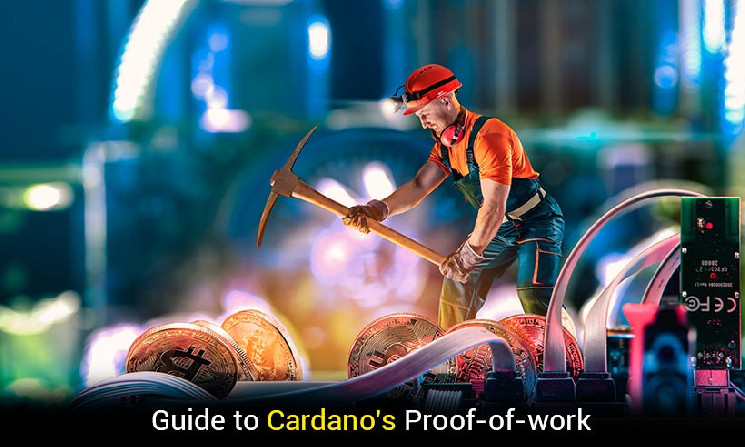Beginners Guide to Cardano’s Non-Interactive Proof-of-work

One of the most prominent blockchain technologies of 2021, Cardano is a cryptocurrency with the fifth-largest market cap. It has also created a native coin called ADA, performing well in the crypto markets. As a network, Cardano uses a sidechain system that involves running two blockchains. The first one is called the Cardano settlement layer (CSL), which acts as the central hub for the ADA. It also serves as the payment gateway for the various settlements within the network, which is very secure and easy to implement. The second layer of the Cardano network is called the Cardano computational layer(CCL). It focuses on smart contract technology. However, it also developed a new technology called NIPoPoW to ensure that the sidechain and mainchain are working efficiently. This guide will look into how these technologies work and their contribution to Cardano Settlement Layer and Cardano computation layer. However, let us first dive into how sidechains work to understand Cardano’s non-interactive proof-of-work.
What are Sidechains?
A sidechain is a system that allows two blockchains to interact seamlessly. Investors can use it to transfer their assets from one blockchain to another. This move will enable them to maintain their value and avoid experiencing volatility. The transaction does not change between one chain and the other. Instead, the token amount is burnt off from the sending chain, and the same amount is created from the second chain. Although the name of the coin is still used for Cardano, it can benefit from the platform’s features. The Cardano network uses the sidechain capability to connect to the various components of the ADA business. The first layer, the CSL, is where all the ADA transactions happen. The second layer, the CCL, will introduce new contract capabilities that allow users to quickly transfer Ada from the CSL to the network’s other components without value loss. If there is a transfer between the mainchain and the sidechain, the sidechain gets the proof of work done and this is where Cardano’s non-interactive proof-of-work comes in.
Cardano’s Non-Interactive Proof-of-work
IOHK, a group of Cardano developers, has introduced a non-interactive proof of work system that helps interlink sidechains. The system, known as NIPoPoWs, verifies a specific event on-chain without requiring the user to download all the details from the source block. Generally, these systems help prove that a particular block happened without requiring the user to download all the data from the genesis block. The main advantage of the blockchain and the sidechain is that they need to work together to ensure that the transactions are efficient. However, this would require the miners in the sidechain to prove that the transactions happened in the CSL. During a transaction, NIPoPoWs take data from the genesis block of a chain. Notably, NIPoPoWs compress data that is usually mega into quickly sent data. Once the receiving party gets the NIPoPoWs, they will prove that they have created money. Every block in a blockchain is enormous. However, according to developers, to complete a block, its hash has to start with ten zeros. In rare cases, a block can begin with 15 hashes, turning into a superblock. A superblock is rare, but showing the proof of a successful block is enough for the work that has been done since the genesis block. A smart contract is similar to a regular contract in that it involves a procedure that consists in hosting it. The goal of the CCL is to provide a variety of smart contracts to the Defi world. The NIPoPoWs can also be used to benefit the ADA. Suppose an individual may want to transfer their ADA from the Cardano Settlement Layer (CSL) to the Cardano Computation Layer(CCL) using a smart contract. This move will only require a single step, and the contract will receive the transfer benefit.
How NIPoPoWs Work
The creation of NIPoPoWs was a way to reduce the complexity of transferring parties. Initially, the concept was known as PoPoW. Still, developers eventually changed it to an interactive one because it involved the sender and the receiver completing various steps to prove a transaction. Since the burn transaction is required to complete before it can create a new transaction, it would involve creating a new transaction that would then collect the data from the previous one. Doing so would result in double transactions. Because the transactions are non-interactive, it eliminates the need for the users to complete them to send the required proof. However, this doesn’t mean the users don’t perform the transactions. Just one transaction will be enough to send the required proof. Notably, mobile wallets would be very useful for the creation and adaptation of NIPoPoWs. These allow users to create a small amount of data they can handle in every transaction. The advantage of this method is that the data does not grow very fast. Due to the nature of the NIPoPoWs technology, sidechains have become very easy to create in Cardano. These sidechains have various features such as scalability, interoperability, and upgradability.
Final Word
Due to the complexity of the Cardano network, the sidechains concept has been in development for a long time. To create a more efficient and transparent transaction between the mainchain and the sidechain, IOHK developed NIPoPoWs. These are designed to help create a more secure and fast transaction between the mainchain and the sidechain. Through Cardano’s non-interactive proof-of-work, a transaction can be shown that happened without giving all the details about it, which speeds up the process and increases the efficiency of financial transactions. This technology could be used by various banks and financial institutions globally.






 Bitcoin
Bitcoin  Ethereum
Ethereum  Tether
Tether  USDC
USDC  TRON
TRON  Dogecoin
Dogecoin  Cardano
Cardano  Bitcoin Cash
Bitcoin Cash  Chainlink
Chainlink  Zcash
Zcash  Monero
Monero  LEO Token
LEO Token  Stellar
Stellar  Litecoin
Litecoin  Hedera
Hedera  Dai
Dai  Cronos
Cronos  Tether Gold
Tether Gold  OKB
OKB  Ethereum Classic
Ethereum Classic  KuCoin
KuCoin  Gate
Gate  Algorand
Algorand  Cosmos Hub
Cosmos Hub  VeChain
VeChain  Dash
Dash  Tezos
Tezos  TrueUSD
TrueUSD  Stacks
Stacks  IOTA
IOTA  Decred
Decred  Basic Attention
Basic Attention  Theta Network
Theta Network  NEO
NEO  Synthetix
Synthetix  Qtum
Qtum  Ravencoin
Ravencoin  DigiByte
DigiByte  0x Protocol
0x Protocol  Nano
Nano  Zilliqa
Zilliqa  Holo
Holo  Siacoin
Siacoin  Numeraire
Numeraire  Waves
Waves  Ontology
Ontology  Status
Status  BUSD
BUSD  Enjin Coin
Enjin Coin  Pax Dollar
Pax Dollar  Hive
Hive  Lisk
Lisk  Steem
Steem  Huobi
Huobi  OMG Network
OMG Network  NEM
NEM  Bitcoin Gold
Bitcoin Gold  Augur
Augur  HUSD
HUSD